

Ancient Jomon clay ear ornaments discovered in western Japan. Remarkably preserved 8th-century flower painting uncovered at Nara temple. NARA--Part of a brightly colored painting of a flower dating back 1,300 years has been discovered on a ceiling at Yakushiji temple during renovations, apparently preserved by chance due to its location.
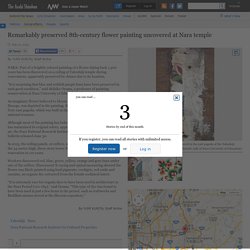
“It is surprising that blue and reddish purple hues have been preserved in such good condition,” said Akihiko Oyama, a professor of painting conservation at Nara University of Education, who surveyed the work. An imaginary flower believed to bloom in the Buddhist paradise, called Hosoge, was depicted in the painting. It was found on the ceiling of the Toto east pagoda, which was built in the early eighth century and is a national treasure.
Although most of the painting has faded over time, a section under a lattice has maintained its original colors, apparently because it was not exposed to air, the Nara National Research Institute for Cultural Properties said in a bulletin released June 30. Workers discovered red, blue, green, yellow, orange and gray hues under one of the coffers. Oldest 'mokkan' found shows Nara name dates back 1,300 years. NARA--A 1,300-year-old “mokkan” wooden tablet found in the remains of Heijokyu palace with an inscription of “Narakyo (or Naranomiyako)” proves that the Nara name has been used since the ancient capital of Japan was established here in 710, researchers say.
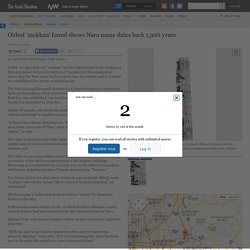
The Nara National Research Institute for Cultural Properties reported on April 30 the mokkan, which is believed to date to the year the capital of Heijokyo was established, was found in the western part of the remains. Narakyo is equivalent to Heijokyo. Akihiro Watanabe, who heads the institute’s historical document section, calls the latest find “a valuable resource.”
Old iron forge that eyes heritage status takes steps toward opening to public. KITA-KYUSHU--A historic iron mill may be opened to the public soon as part of a campaign to have it registered as a UNESCO World Heritage site.
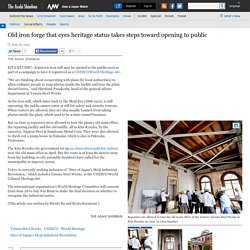
“We are thinking about cooperating with plans (by local authorities) to allow ordinary people to snap photos inside the facility and tour the plant aboard buses,” said Hirofumi Funakoshi, head of the general-affairs department at Yawata Steel Works. As the iron mill, which dates back to the Meiji Era (1868-1912), is still operating, the public cannot enter at will for safety and security reasons. When visitors are allowed, they are also usually banned from taking photos inside the plant, which used to be a state-owned business. But on June 15 reporters were allowed to tour the plant’s old main office, the repairing facility and the old smithy, all in Kita-Kyushu, by the operator, Nippon Steel & Sumitomo Metal Corp. They were also allowed to check out a pump house in Nakama, which is also in Fukuoka Prefecture. Tokyo printing firm to digitize 55 historic globes for viewing online.
Globes dating as far back as the 11th century will be digitally copied by a Tokyo-based printing company so that they can be viewed on computers and other digital devices in 3-D.

Dai Nippon Printing Co. will digitally copy 55 of the historic terrestrial and celestial globes in the National Library of France’s collection so that people can view them on screen. 'Shunga' show hopes to open Japanese eyes to 'taboo' Edo erotic woodblocks prints. Wedding trousseau of Edo Period princess on display. Watercolor by Meiji Era poet Shiki Masaoka done in sickbed uncovered. MATSUYAMA--A watercolor by Shiki Masaoka (1867-1902) created five months before his death has been recently discovered, a museum here dedicated to the poet announced.
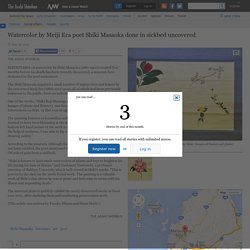
The Shiki Museum acquired a small number of watercolors and letters by the renowned Meiji Era (1868-1912) poet, all of which had been previously unknown to the public, from an individual in Saitama Prefecture. One of the works, "Shiki Koji Shaseiga (Sokazu)" (Sketches by Shiki: Images of plants and flowers), was dated April 13, 1902. Shiki died from tuberculosis on Sept. 19 that year at age 34. Photos, letters from family of China’s last emperor on display in Hyogo. NISHINOMIYA, Hyogo Prefecture--Letters and photographs that once belonged to the brother of the last emperor of China are the focus of an exhibition here at the Kwansei Gakuin University Museum.
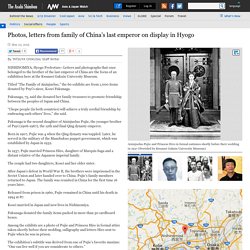
Titled “The Family of Aixinjueluo,” the 60 exhibits are from 1,000 items donated by Puyi’s niece, Kosei Fukunaga. Fukunaga, 75, said she donated her family treasures to promote friendship between the peoples of Japan and China. “I hope people (in both countries) will achieve a truly cordial friendship by embracing each others' lives,” she said. ‘Visas for Life’ that saved Jews from Holocaust to be submitted for UNESCO inclusion. YAOTSU, Gifu Prefecture--Lists of transit visas issued by a Japanese diplomat to European Jews allowing them to escape Nazi persecution during World War II will be recommended for inclusion in UNESCO’s Memory of the World Program.
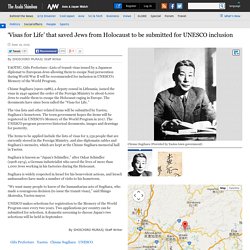
Chiune Sugihara (1900-1986), a deputy consul in Lithuania, issued the visas in 1940 against the order of the Foreign Ministry to about 6,000 Jews to enable them to escape the Holocaust raging in Europe. YOUNG KAMIKAZE. Nagasaki team finds film of U.S. troops surveying city shortly after A-bomb attack. WASHINGTON--A Japanese delegation has discovered film footage of U.S. occupation forces surveying damage from the Aug. 9, 1945, atomic bombing of Nagasaki, less than two months after the attack on the city.
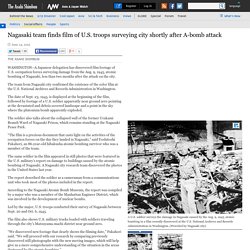
1945 medical records detail Saga hospital's struggle to treat A-bomb victims. SAGA--Doctors made frantic but often futile efforts to ease the painful symptoms among people who returned to Saga Prefecture soon after being exposed to radiation in the 1945 atomic bombings, medical records show.
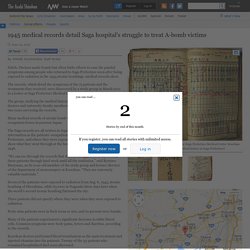
The records, which detail the symptoms of the 75 patients and the treatments they received, were discovered by a study group in March 2011 in a locker at Saga Prefecture Medical Center Koseikan in Saga city. The group, studying the medical history of Saga Prefecture and comprising doctors and university faculty members in the prefecture, spent around two years surveying the records. Many medical records of atomic bomb victims were confiscated by U.S. -led occupation forces in postwar Japan. The Saga records are all written in Japanese and German and contain such information as the patients’ occupations, age, sex, home addresses in Saga Prefecture, and where they were exposed to radiation.
Hiroshima painting hands down warning of man who collected bodies for A-bomb research. HIROSHIMA--A masterpiece by an artist who painted many works themed on the 1945 atomic bombing of this city while collecting victims’ bodies for a U.S. research institute will be donated to the city.

Reiko Sasaki, the 75-year-old widow of Torao Sasaki, who did more than 100 compositions on the agony of "hibakusha" survivors of the world’s first nuclear bombing, decided to present the 1982 work titled “Kaiki” (Recursion) for public display. The abstract piece was inspired by a 1971 excavation of skeletal remains of A-bomb victims. “I hope this painting will hand down a warning by my husband for posterity,” said Reiko, whose husband died seven years ago at age 70.
Wartime documents shed light on Japan’s secret A-bomb program. Long-forgotten documents on Japan's attempt to build an atomic bomb during World War II have been discovered at Kyoto University, which experts say further confirms the secret program's existence and could reveal the level of the research. The newly found items, dating between October and November 1944, were stored at Kyoto University’s research center.
At 94, woman writes daily love notes to husband who died in World War II. ITOSHIMA, Fukuoka Prefecture--Frail with age, Tsuchie Okushi nonetheless continues her daily ritual of writing love notes to her husband whom she last saw alive in 1942. Shunsuke Tsurumi, philosopher and leading anti-war activist, dies at 93. Shunsuke Tsurumi, a liberal philosopher who led postwar peace movements and protests against the Vietnam War, died of pneumonia at a hospital in Kyoto on July 20, his eldest son said July 24. He was 93. Born in Tokyo in 1922 to influential politician Yusuke Tsurumi, the son entered Harvard University’s Department of Philosophy in 1939.
In March 1942, after the Pacific War broke out, U.S. authorities accused Tsurumi of being an anarchist and arrested him. He returned to Japan on a wartime exchange ship, and then worked as a civilian employee for the Imperial Japanese Navy mainly as a translator and an editor for a naval intelligence paper for high-ranking officials in Indonesia.
A year after Japan’s surrender, he founded the Shiso no Kagaku (Science of thinking) magazine with leading economist Shigeto Tsuru and political theorist Masao Maruyama to introduce “pragmatism,” a philosophical tradition that originated in the United States. Nagoya war archives enable viewers to look inward. NAGOYA--Among the 400 or so items at the newly opened Aichi-Nagoya war archives are the personal diaries of children who were evacuated to rural areas during World War II and the draft cards of soldiers of the Imperial Japanese Army. The war archives offer a different take to conventional museums. There are no detailed explanations here. Photo book of blackboard drawings from 1950s shows minds of postwar children. Tokyo native creates database of Japanese-Americans interned in Hawaii.
By YUSUKE OGAWA/ Staff Writer HONOLULU--A retired airline employee from Japan has completed a database detailing the names, occupations and personal histories of Japanese-Americans in Hawaii who were forced into internment camps during World War II. Japanese language newspapers face extinction in the Americas. Toshiro Mifune to get star on Hollywood Walk of Fame. Helen Keller’s letter written during 1937 Japan visit retains power to inspire. OSAKA--A letter written by the American deaf-blind activist Helen Keller (1880-1968) during her first visit to Japan has been discovered, offering fresh inspiration for those working for disabled people. Breaking taboo, Chinese newspaper carries editorial on Tiananmen. Hyogo ceremony honors slain Asahi reporter on 28th anniversary of death. Stepping into the U.S. Embassy in Tehran is a step back in time to 1979 - DecodeDC Story.
Messages from victims of 1985 JAL crash still guide families 30 years later. In a final poignant act, Masakatsu Taniguchi scrawled a message to his family on an air sickness bag before JAL Flight 123 crashed on Aug. 12, 1985, the deadliest single-aircraft accident in history. “Machiko, please take good care of our children,” Taniguchi, 40, wrote to his wife. Rohingya live in limbo in Japan, fear for those floating in boats at sea. Ainu museum planned for 2020 to promote understanding of indigenous people. Elegant Art Deco-era museum in Tokyo offers indigenous masks in natural light. Survey: 50 percent of foreigners in Saitama feel discriminated against. Young woman with cerebral palsy discovers voice through poetic word.
Exhibition shows influence of Nippon Animation studio on Tama city. Manga artist’s drawings showcase rich diversity of Japanese language. Website shares photos, memories of evacuated Fukushima town. POINT OF VIEW/ Genichiro Takahashi: Time to relearn the ‘fundamental spirit’ of democracy. Political Comics: Japan Radicalism and New Left Protest Movements Told Through Manga. How the KitKat became a phenomenon in Japan. Scientists discover ‘under-seabed forest’ dating back 20 million years off Aomori. A Futuristic Place to Rest: Q&A with Noriko Hayashi.